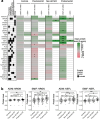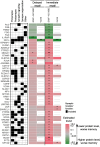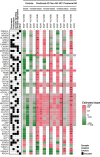Synaptic protein CSF levels relate to memory scores in individuals without dementia
- PMID: 40033427
- PMCID: PMC11877693
- DOI: 10.1186/s13195-025-01703-z
Synaptic protein CSF levels relate to memory scores in individuals without dementia
Abstract
Background: We investigated how cerebrospinal fluid levels of synaptic proteins associate with memory function in normal cognition (CN) and mild cognitive impairment (MCI), and investigated the effect of amyloid positivity on these associations.
Methods: We included 242 CN (105(43%) abnormal amyloid), and 278 MCI individuals (183(66%) abnormal amyloid) from the European Medical Information Framework for Alzheimer's Disease Multimodal Biomarker Discovery (EMIF-AD MBD) and the Alzheimer's Disease Neuroimaging Initiative (ADNI). For 181 (EMIF-AD MBD) and 36 (ADNI) proteins with a synaptic annotation in SynGO, associations with word learning recall were analysed with linear models.
Results: Subsets of synaptic proteins showed lower levels with worse recall in preclinical AD (EMIF-AD MBD: 7, ADNI: 5 proteins, none overlapping), prodromal AD (EMIF-AD MBD only, 27 proteins) and non-AD MCI (EMIF-AD MBD: 1, ADNI: 7 proteins). The majority of these associations were specific to these clinical groups.
Conclusions: Synaptic disturbance-related memory impairment occurred very early in AD, indicating it may be relevant to develop therapies targeting the synapse early in the disease.
Keywords: Cerebrospinal fluid proteomics; Early Alzheimer’s disease; Memory performance; Synaptic proteins.
© 2025. The Author(s).
Conflict of interest statement
Declarations. Ethics approval and consent to participate: For both ADNI and EMIF-AD MBD, Local institutional review boards approved the procedures for this study and written informed consent was obtained in accordance with the Declaration of Helsinki. Supplementary Table 4 contains a full overview of Ethical Committee/IRB names of each center. Consent for publication: Not applicable. Competing interests: KB has served as a consultant, at advisory boards, or at data monitoring committees for Abcam, Axon, BioArctic, Biogen, JOMDD/Shimadzu. Julius Clinical, Lilly, MagQu, Novartis, Pharmatrophix, Prothena, Roche Diagnostics, and Siemens Healthineers, and is a co-founder of Brain Biomarker Solutions in Gothenburg AB (BBS), which is a part of the GU Ventures Incubator Program, outside the work presented in this paper. HZ has served at scientific advisory boards and/or as a consultant for Abbvie, Alector, Annexon, Artery Therapeutics, AZTherapies, CogRx, Denali, Eisai, Nervgen, Pinteon Therapeutics, Red Abbey Labs, Passage Bio, Roche, Samumed, Siemens Healthineers, Triplet Therapeutics, and Wave, has given lectures in symposia sponsored by Cellectricon, Fujirebio, Alzecure, Biogen, and Roche, and is a co-founder of Brain Biomarker Solutions in Gothenburg AB (BBS), which is a part of the GU Ventures Incubator Program. PS has acquired grants for the institution from GE Healthcare and Piramal and received consultancy/speaker fees paid to the institution from Novartis, Probiodrug, Biogen, Roche, and EIP Pharma, LLC in the past 2 years. CT received grants from the European Commission, the Dutch Research Council (ZonMW), Association of Frontotemporal Dementia/Alzheimer’s Drug Discovery Foundation, The Weston Brain Institute, Alzheimer Netherlands. Prof. dr. Teunissen has functioned in advisory boards of Roche, received non-financial support in the form of research consumables from ADxNeurosciences and Euroimmun, performed contract research or received grants from Probiodrug, Biogen, Esai, Toyama, Janssen Prevention Center, Boehringer, AxonNeurosciences, EIP farma, PeopleBio, Roche. The other authors report no conflict of interest.
Figures





Update of
-
Synaptic protein CSF levels relate to memory scores in individuals without dementia.Res Sq [Preprint]. 2024 Jul 23:rs.3.rs-4607202. doi: 10.21203/rs.3.rs-4607202/v1. Res Sq. 2024. Update in: Alzheimers Res Ther. 2025 Mar 03;17(1):56. doi: 10.1186/s13195-025-01703-z. PMID: 39108495 Free PMC article. Updated. Preprint.
References
-
- ADNI General Procedures Manual [WWW Document], 2006. URL http://adni.loni.usc.edu/wp-content/uploads/2010/09/ADNI_GeneralProcedur.... Accessed 13 Aug 2020.
-
- Arendt T. Synaptic degeneration in Alzheimer’s disease. Acta Neuropathol. 2009;118:167–79. 10.1007/s00401-009-0536-x. - PubMed
-
- Batth TS, Francavilla C, Olsen JV. Off-line high-pH reversed-phase fractionation for in-depth phosphoproteomics. J Proteome Res. 2014;13:6176–86. 10.1021/pr500893m. - PubMed
-
- Bos I, Vos S, Vandenberghe R, Scheltens P, Engelborghs S, Frisoni G, Molinuevo JL, Wallin A, Lleó A, Popp J, Martinez-Lage P, Baird A, Dobson R, Legido-Quigley C, Sleegers K, Van Broeckhoven C, Bertram L, ten Kate M, Barkhof F, Zetterberg H, Lovestone S, Streffer J, Visser PJ. The EMIF-AD Multimodal Biomarker Discovery study: design, methods and cohort characteristics. Alzheimers Res Ther. 2018;10:64. 10.1186/s13195-018-0396-5. - PMC - PubMed
MeSH terms
Substances
Grants and funding
- 201809-2016862/Alzheimer's Drug Discovery Foundation
- ZEN-21-848495/ALZ/Alzheimer's Association/United States
- ALFGBG-720931/Swedish State Support for Clinical Research
- AF-742881/Swedish Alzheimer Foundation
- 2018-02532/Swedish Research Council
- RDAPB-201809-2016615/Alzheimer's Drug Discovery Foundation
- U01 AG024904/AG/NIA NIH HHS/United States
- AF-930934/Alzheimerfonden
- U01 AG024904/NH/NIH HHS/United States
- JPND2019-466-236/European Union Joint Program for Neurodegenerative Disorders
- FO2018-0315/Hjärnfonden
- 681712/ERC_/European Research Council/International
- FO2017-0243/Hjärnfonden
- ALFGBG-715986/the Swedish state under the agreement between the Swedish government and the County Councils, the ALF-agreement
- 2017-00915/Swedish Research Council
- 1R01AG068398-01/NH/NIH HHS/United States
- 733050824/ZONMW_/ZonMw/Netherlands
- ADSF-21-831376-C, #ADSF-21-831381-C and #ADSF-21-831377-C/AD strategic Fund and Alzheimer's Association
- JPND2021-00694/European Union Joint Program for Neurodegenerative Disorders
- FO2019-0228/Hjärnfonden
- 860197/European Union's Horizon 2020 research and innovation programme under the Marie Skłodowska-Curie grant agreement
- 115372/Innovative Medicines Initiative
LinkOut - more resources
Full Text Sources
Medical

